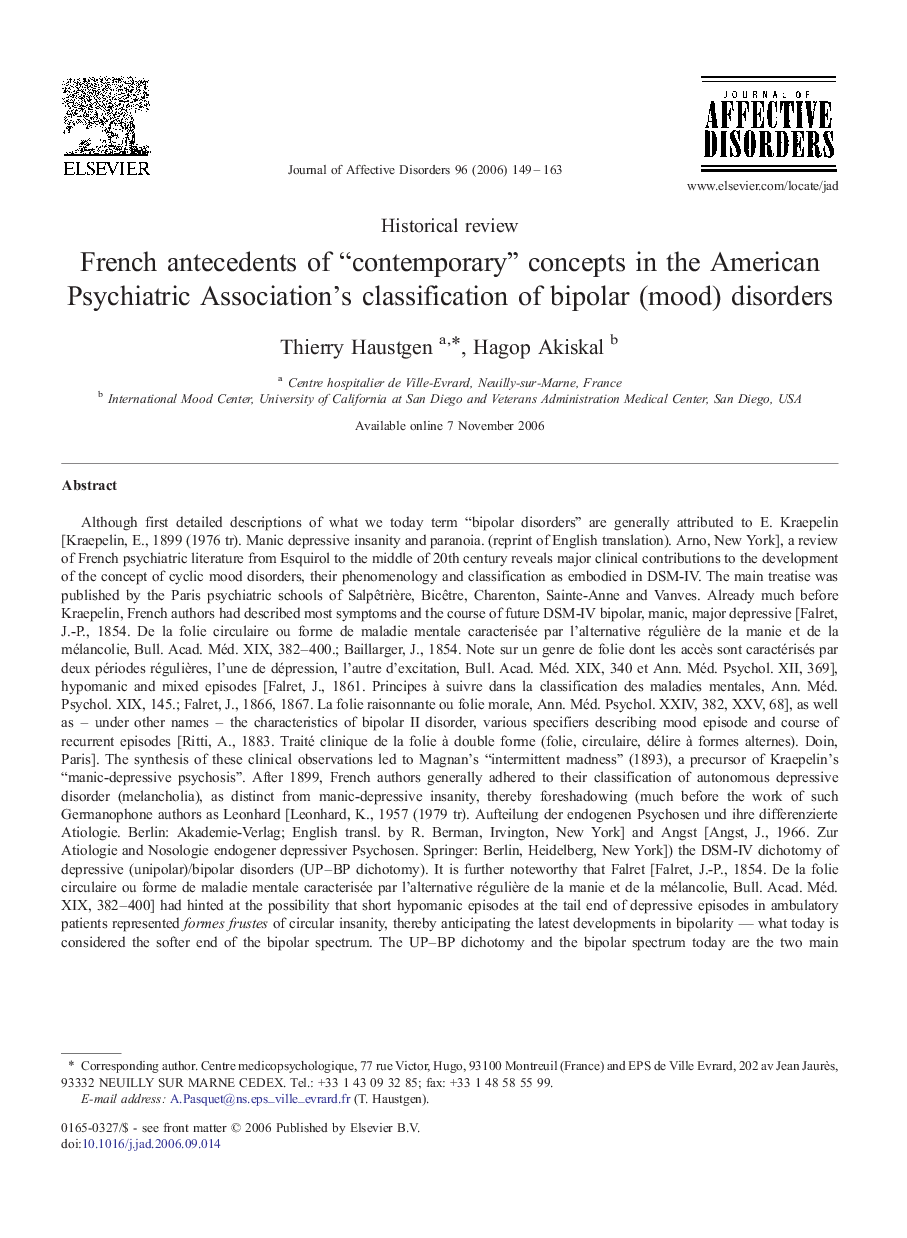| کد مقاله | کد نشریه | سال انتشار | مقاله انگلیسی | نسخه تمام متن |
|---|---|---|---|---|
| 4187790 | 1277645 | 2006 | 15 صفحه PDF | دانلود رایگان |
عنوان انگلیسی مقاله ISI
French antecedents of “contemporary” concepts in the American Psychiatric Association's classification of bipolar (mood) disorders
دانلود مقاله + سفارش ترجمه
دانلود مقاله ISI انگلیسی
رایگان برای ایرانیان
کلمات کلیدی
موضوعات مرتبط
علوم پزشکی و سلامت
پزشکی و دندانپزشکی
روانپزشکی و بهداشت روانی
پیش نمایش صفحه اول مقاله

چکیده انگلیسی
Although first detailed descriptions of what we today term “bipolar disorders” are generally attributed to E. Kraepelin [Kraepelin, E., 1899 (1976 tr). Manic depressive insanity and paranoia. (reprint of English translation). Arno, New York], a review of French psychiatric literature from Esquirol to the middle of 20th century reveals major clinical contributions to the development of the concept of cyclic mood disorders, their phenomenology and classification as embodied in DSM-IV. The main treatise was published by the Paris psychiatric schools of Salpêtrière, Bicêtre, Charenton, Sainte-Anne and Vanves. Already much before Kraepelin, French authors had described most symptoms and the course of future DSM-IV bipolar, manic, major depressive [Falret, J.-P., 1854. De la folie circulaire ou forme de maladie mentale caracterisée par l'alternative régulière de la manie et de la mélancolie, Bull. Acad. Méd. XIX, 382-400.; Baillarger, J., 1854. Note sur un genre de folie dont les accès sont caractérisés par deux périodes régulières, l'une de dépression, l'autre d'excitation, Bull. Acad. Méd. XIX, 340 et Ann. Méd. Psychol. XII, 369], hypomanic and mixed episodes [Falret, J., 1861. Principes à suivre dans la classification des maladies mentales, Ann. Méd. Psychol. XIX, 145.; Falret, J., 1866, 1867. La folie raisonnante ou folie morale, Ann. Méd. Psychol. XXIV, 382, XXV, 68], as well as - under other names - the characteristics of bipolar II disorder, various specifiers describing mood episode and course of recurrent episodes [Ritti, A., 1883. Traité clinique de la folie à double forme (folie, circulaire, délire à formes alternes). Doin, Paris]. The synthesis of these clinical observations led to Magnan's “intermittent madness” (1893), a precursor of Kraepelin's “manic-depressive psychosis”. After 1899, French authors generally adhered to their classification of autonomous depressive disorder (melancholia), as distinct from manic-depressive insanity, thereby foreshadowing (much before the work of such Germanophone authors as Leonhard [Leonhard, K., 1957 (1979 tr). Aufteilung der endogenen Psychosen und ihre differenzierte Atiologie. Berlin: Akademie-Verlag; English transl. by R. Berman, Irvington, New York] and Angst [Angst, J., 1966. Zur Atiologie and Nosologie endogener depressiver Psychosen. Springer: Berlin, Heidelberg, New York]) the DSM-IV dichotomy of depressive (unipolar)/bipolar disorders (UP-BP dichotomy). It is further noteworthy that Falret [Falret, J.-P., 1854. De la folie circulaire ou forme de maladie mentale caracterisée par l'alternative régulière de la manie et de la mélancolie, Bull. Acad. Méd. XIX, 382-400] had hinted at the possibility that short hypomanic episodes at the tail end of depressive episodes in ambulatory patients represented formes frustes of circular insanity, thereby anticipating the latest developments in bipolarity - what today is considered the softer end of the bipolar spectrum. The UP-BP dichotomy and the bipolar spectrum today are the two main competing nosologic conceptual frames for mood disorders in both American and European psychiatry - and world psychiatry at large.
ناشر
Database: Elsevier - ScienceDirect (ساینس دایرکت)
Journal: Journal of Affective Disorders - Volume 96, Issue 3, December 2006, Pages 149-163
Journal: Journal of Affective Disorders - Volume 96, Issue 3, December 2006, Pages 149-163
نویسندگان
Thierry Haustgen, Hagop Akiskal,